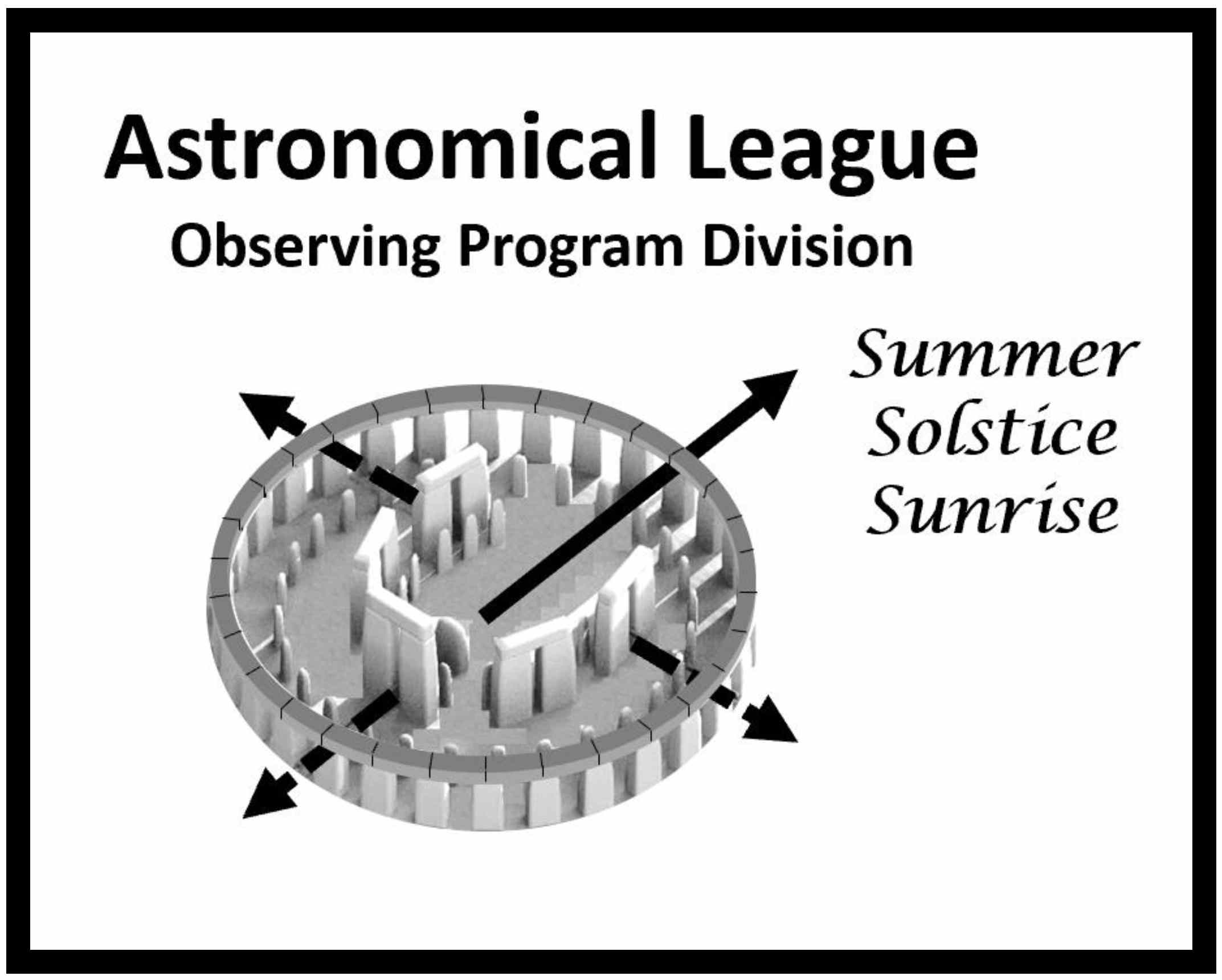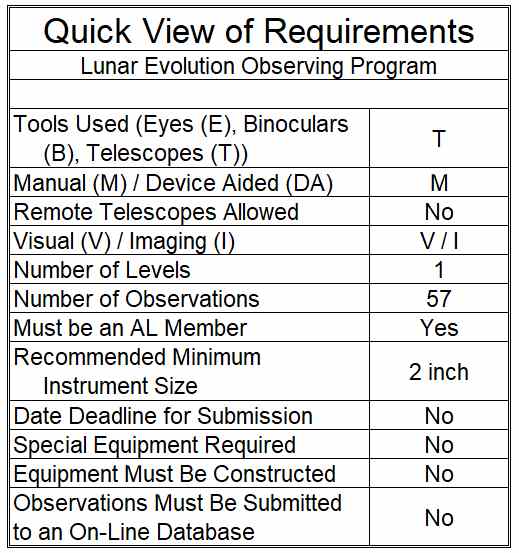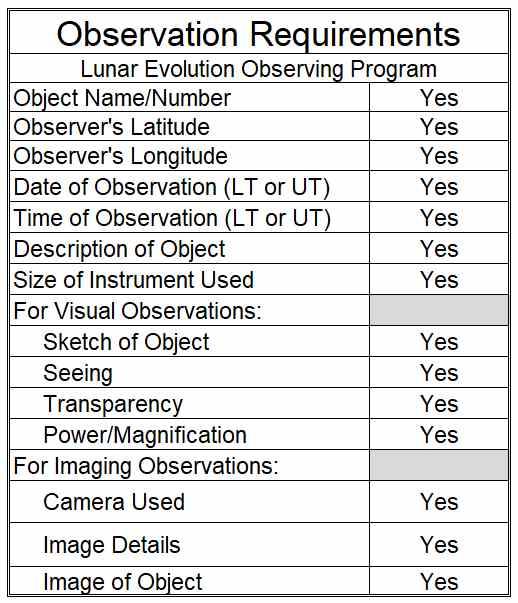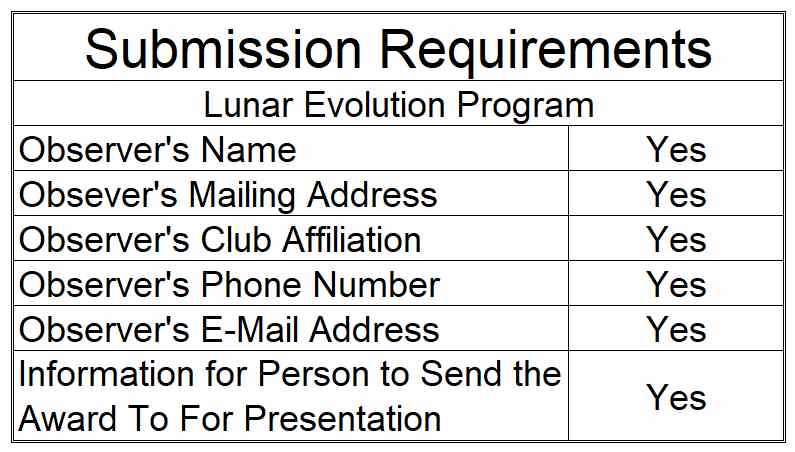Lunar Evolution Observing Program Coordinator:Charles E. Allen, III |
  |
IntroductionKnowledge of Earth’s Moon changed greatly with explorations done by the Apollo missions. Much of what we know of the Moon’s composition, structure, and origin came from information gathered by the six Apollo flights that landed on the Moon. To complete this Observing Program, you will explore the sites of the lunar landings and features from the six eras of Lunar Evolution. Future lunar landings are starting to seem more likely to happen. We will undoubtedly learn much more about the Moon from them. There are many questions still to be answered. Going through this Observing Program will further your interest and understanding of these future missions. Most observations of the features should be done when the features are close to the terminator (local morning or evening) to get the best contrast of the features and terrain. Some observations should be done with a high sun (local noon) to emphasize the different areas of brightness to understand how the Moon developed. A new theory for the formation of the Moon was developed due to the results of the Apollo findings. It is now believed that the Moon was formed about 4.6 billion years ago (about 100 million years after the birth of the Solar System) when the Earth was impacted by a Mars-sized body named Theia. The debris blasted into space and formed a disk that coalesced into the Moon. This modern scientific theory, based on evidence from data gathered from the Apollo missions, supplanted previous theories including a captured Moon, fission – the Earth spinning and losing the area that is now the Pacific Ocean, and co-accretion – the concurrent formation of both the Moon and Earth from a common primordial disk encircling the Sun. |
 |
Background Information
Stages in Lunar Evolution:
- The Pre-Nectarian Era: started when the lunar crust formed 4.6-4.5 billion years ago and ended with the large impact that created the Nectaris Basin 3.92 billion years ago. Prenectarian rocks are rare which suggests that a global ocean of magma cooled to become lunar crust. Lighter materials are on top and heavier are on the bottom. Heavier materials in the lunar maria formed from lava deep within the Moon. The absence of water, sodium, and potassium suggests that the magma was extremely hot and these elements burned off into space. Craters from this era have broken down walls and are often pockmarked with smaller craters.
- The Nectarian Era: started with the formation of the Nectarian Basin and ended with the formation of Mare Imbrium. During this time of heavy bombardment, most of the large basins were formed. The Nectarian Period of the lunar geologic timescale runs from 3920 million years ago to 3850 million years ago. It is the period during which the Nectaris Basin and other major basins were formed by large impact events. Ejecta from Nectaris forms the upper part of the densely cratered terrain found in the lunar highlands.
- The Imbrian Era is divided into two parts: The Early Imbrian Era and the Late Imbrian Era.
- The Early Imbrian Era: marks the end of the heavy bombardment of the Inner Solar System. It started with the creation of the Mare Imbrium basin and lasted about 50 million years from 3850 million years ago to 3800 million years ago. Other large basins – Crisium, Tranquilitatis, Serenitatis, Fecuditatis, and Procellarum – were also formed during this period.
- The Late Imbrian Era: during this period, the basins that had formed during the earlier periods were filled with basalt lava giving us the Maria, the “seas”, that we see today on the Moon. This occurred from 3800 to 3200 million years ago.
- The Eratosthenian Era: ran from 3200 to 1100 million years ago. Craters from this era often have little erosion from subsequent impacts but also do not possess a ray system.
- The Copernican Era: started about 1100 million years ago to present day and features craters with bright ray systems. Rays deteriorate over time due to the space weathering process. In theory, then the brightest rays come from the youngest craters. An exception is when bright ejecta lands on dark basalt. Then it will take a longer time to weather.
Apollo Landing Site Observations:
Note:If you earned the NASA Apollo 50th Observing Challenge certificate in 2019, mention that fact in your submission and you will receive credit for these observations.
Observe and comment on all 6 sites and sketch or image them annotating some of the features listed. Before observing you might research the Landing site selection and view some pictures. This will enhance the observation of each site.
Note: Normally you will see more detail viewing directly but imaging definitely helps with details. Sketching makes you more observant and more aware of details.
- Apollo 11 Site. Sketch the site area and label craters Ritter, Sabine, Moltke, (Aldrin, Collins, and Armstrong if you see them). Mark the location of the Apollo 11 landing. Discuss why this site was chosen.
- Apollo 12 Site. Sketch the site area and label craters Landsberg, Reinhold, Montes Riphaeus, and Fra Mauro B. Under the right lighting conditions, some domes in Montes Riphaeus delta will be visible. Mark the location of the Apollo 12 landing. Discuss why this site was chosen.
- Apollo 14 Site. Sketch this site area and label the features Fra Mauro and craters Bonpland, and Parry. Mark the location of the Apollo 14 landing. Discuss why this site was chosen.
- Apollo 15 Site. Sketch this site area and label features Rima Hadley, Mons Hadley, and the location of the Apollo 15 landing. Aristillius, Archimedes, Autolycus, Palus Putredenis, and Conon are useful guideposts. Discuss why this site was chosen.
- Apollo 16 Site. Sketch this site area and label craters Lindsey, Dolland B, Dolland, and the Apollo 16 Landing. At a high sun angle observe the South Ray and the North Ray. Discuss why this site was chosen.>
- Apollo 17 Site. Sketch this site and label craters Littrow and Vitruvius, the features Mons Argaeus, and the Apollo 17 landing. Under a low sun angle, you can see the Sculptured Hills, South Massif, North Massif, and the Taurus Littrow Valley. Discuss why this site was chosen.
Requirements and Rules
This certification is available to members of the Astronomical League, either through their local astronomical society or as members at large. If you are not a member and would like to become one, check with your local astronomical society, search for a local society on the Astronomical League Website, or join as a member-at-Large.
| There are two different ways to earn this certification. You may view the objects visually (with your eyes) and make the appropriate sketches, or you may image all of the objects.
Several objects must be observed twice, in different light and shadow conditions, as specified in the object list. You may substitute up to 5 features (not Apollo Sites) as long as they are the same epoch as the one for which they are being substituted. To earn a Lunar Evolution Observing Program certificate and pin you must:
|
 |
Submitting for Certification
| Submit a COPY of your observing log and sketches to the Lunar Evolution Observing Program Coordinator for review and certification (it will not be returned to you). You may send a printout, a scanned document, or a text file. If imaging, include a link to your images or media containing the files.
Include your name, Lunar Observing Program certificate number, whether you earned the NASA Observing Challenge – Apollo 50th Anniversary Certificate, mailing address, email address, telephone number, and the name of your local astronomy club or society. If you are a Member at Large, indicate this. |
 |
Upon verification of your submission and of your active membership in the Astronomical League, your recognition (certificate, pin, etc.) will be sent to you or to the awards coordinator for your society, as you specified. Your name will also appear in an upcoming issue of the Reflector magazine and in the Astronomical League’s online database. Congratulations. Good luck with your next observing challenge.
IF YOU SUBMIT BY EMAIL AND DO NOT RECEIVE A CONFIRMATION EMAIL FROM ME WITHIN 48 HOURS, PLEASE NOTIFY ME BY PHONE OR TEXT. THANK YOU.
Lunar Evolution Observing Program Coordinator:
Charles E. Allen, III
4005 St. Germaine Ct.
Louisville, KY 40207
(502) 693-5504
E-mail: chuckallen@gmail.com
Notes:
Acknowledgements: We would like to thank Rocky Togni for creating this Observing Program for the Astronomical League. Thank you Rocky.
Links:
- Lunar Evolution Checklist (pdf file or MS Excel file)
- Find Your Observing Program Certificate



